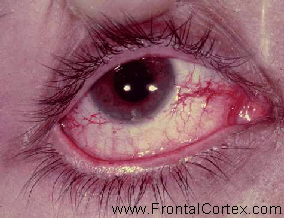Last modified on Saturday, February 17 2007.

Image courtesy of National Eye Institute, National Institutes of Health
A 6 year-old female presents with a history of choreoathetosis, ataxia of the limbs, grimacing, and dysarthric speech, which have been slowly progressing since early childhood.
On exam, you notice the eye findings shown in the image above.
This child is at increased risk for all of the following complications, EXCEPT:
This patient's history and eye findings are diagnostic for ataxia-telangiectasia. This is associated with an increased risk of T-cell acute lymphatic leukemia (
This patient's history and eye findings are diagnostic for ataxia-telangiectasia. This is associated with an increased risk of early greying of the hair. (
This patient's history and eye findings are diagnostic for ataxia-telangiectasia. This is associated with increased cellular sensitivity to ionizing radiation. (
This patient's history and eye findings are diagnostic for ataxia-telangiectasia. Port wine stain is associated with Sturge-Weber syndrome, not ataxia-telangiectasia. (
This patient's history and eye findings are diagnostic for ataxia-telangiectasia. This is associated with an increased risk of nonlymphoid neoplasms (
| 1. Santos, C.C., Miller, V.S., and Roach, E.S. (2004). Neurocutaneous syndromes. In Bradley, W.G., Daroff, R.B., Fenichel, G.M., and Jankovic, J. (Eds.). Neurology in Clinical Practice, 4th Edition. Butterworth Heinemann, Philadelphia. Pp. 1867-1900. | |
| 2. NINDS Ataxia Telangiectasia Information Page, NINDS. http://www.ninds.nih.gov/disorders/a_t/a-t.htm | |
| 3. Victor, M., and Ropper, A.H. (2001). Adams and Victor's Principles of Neurology, 7th Edition. McGraw-Hill, New York. Pp. 1011-1012. | |
























